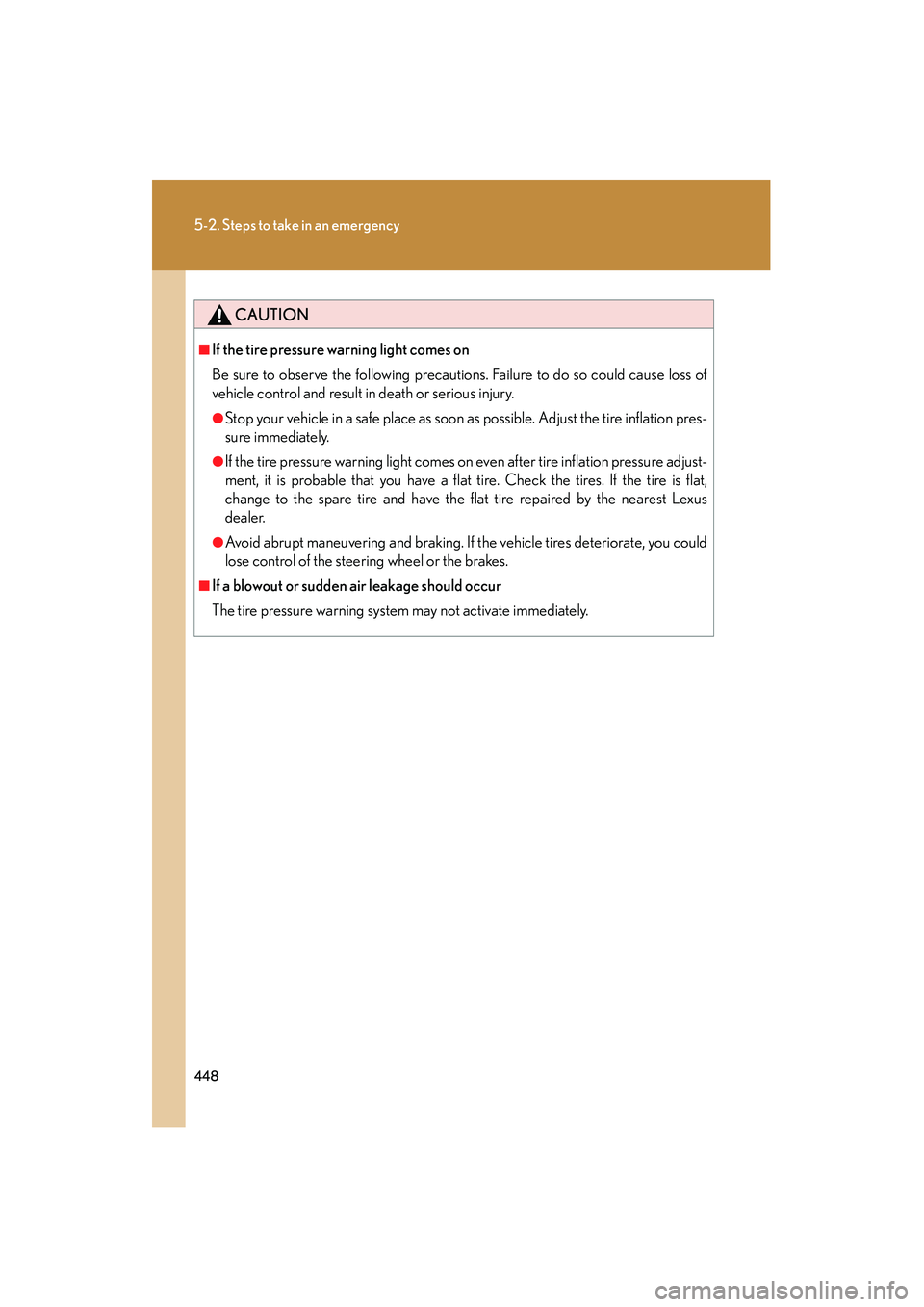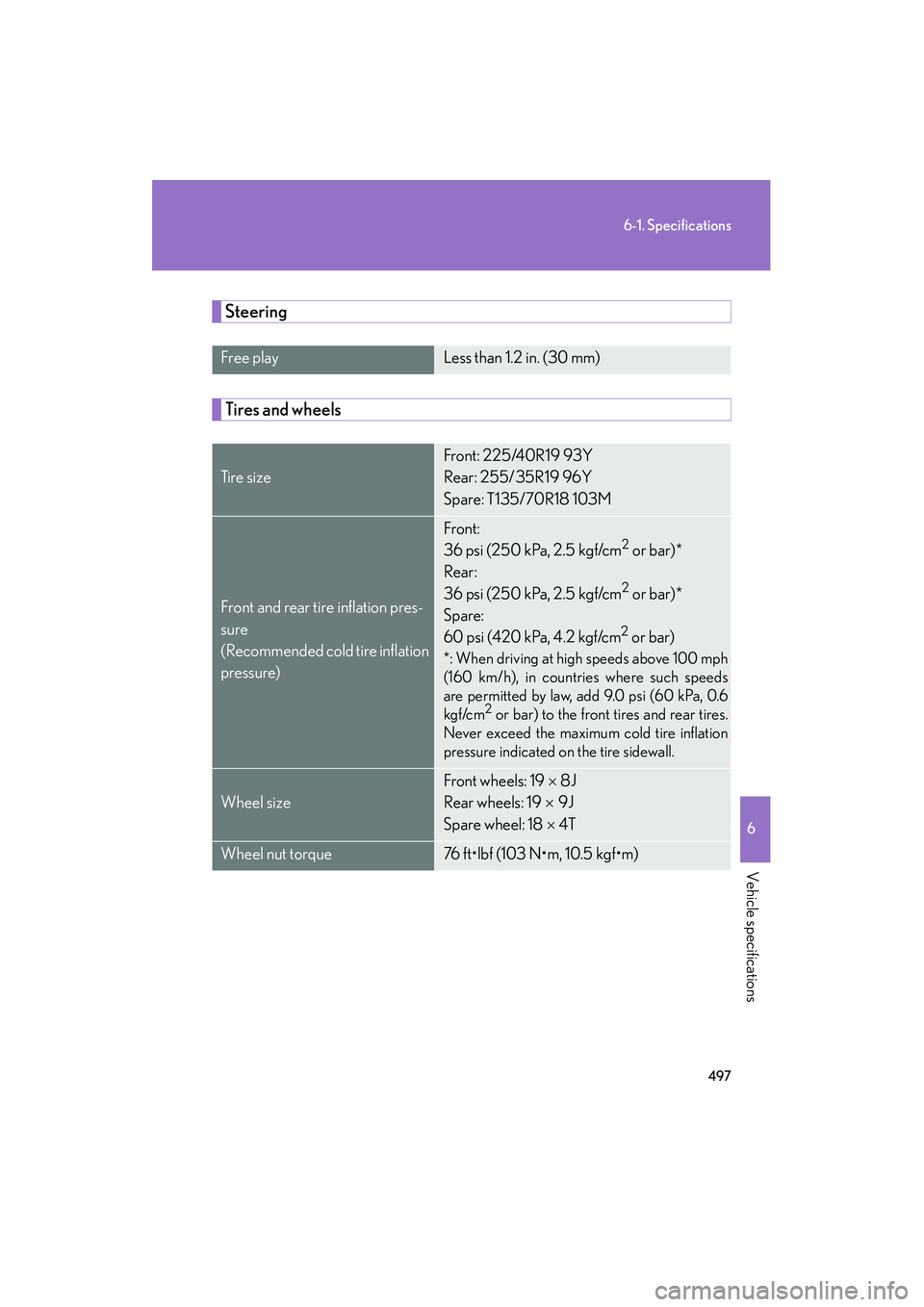steering Lexus IS F 2010 Repair Manual
[x] Cancel search | Manufacturer: LEXUS, Model Year: 2010, Model line: IS F, Model: Lexus IS F 2010Pages: 542, PDF Size: 6.77 MB
Page 436 of 542

5
When trouble arises
435
5-1. Essential information
10_IS F_U
Towing with a wheel lift-type truckFrom the front Use a towing dolly under the rear
wheels.
From the rear Turn the “ENGINE START STOP”
switch to the ACCESSORY mode
so that the steering wheel is
unlocked.
NOTICE
■To prevent causing serious damage to the transmission
Never tow this vehicle from the front with the rear wheels on the ground.
■To prevent damaging the vehicle
●Do not tow the vehicle from the rear with the “ENGINE START STOP” switch
OFF.
The steering lock mechanism is not strong enough to hold the front wheels
straight.
●When raising the vehicle from the rear, ensure adequate ground clearance for
towing at the opposite end of the raised vehicle. Without adequate clearance, the
vehicle could be damaged while being towed from the rear.
Page 444 of 542

5
When trouble arises
443
5-2. Steps to take in an emergency
10_IS F_U
Warning lightWarning light/Details
(U.S.A.)
(Canada)
ABS warning lightIndicates a malfunction in:
•The ABS; or
• The brake assist system.
Electric power steering warning lightIndicates a malfunction in the EPS (Electric Power Steering)
system.
Pre-collision system warning light (if equipped)Indicates a malfunction in the pre-collision system.
■Electric power steering warning light
When the battery is low or when the voltage drops temporarily, the electric power
steering warning light may come on.
CAUTION
■When the electric power steering warning light comes on
The steering wheel may become extremely heavy.
If the steering wheel becomes heavier than usual when operating, firmly hold and
operate it using more force than usual.
Page 449 of 542

448
5-2. Steps to take in an emergency
10_IS F_U
CAUTION
■If the tire pressure warning light comes on
Be sure to observe the following precautions. Failure to do so could cause loss of
vehicle control and result in death or serious injury.
●Stop your vehicle in a safe place as soon as possible. Adjust the tire inflation pres-
sure immediately.
●If the tire pressure warning light comes on even after tire inflation pressure adjust-
ment, it is probable that you have a flat tire. Check the tires. If the tire is flat,
change to the spare tire and have the flat tire repaired by the nearest Lexus
dealer.
●Avoid abrupt maneuvering and braking. If the vehicle tires deteriorate, you could
lose control of the steering wheel or the brakes.
■If a blowout or sudden air leakage should occur
The tire pressure warning system may not activate immediately.
Page 454 of 542

5
When trouble arises
453
5-2. Steps to take in an emergency
10_IS F_U
Have the vehicle inspected by your Lexus dealer immediately.
A buzzer sounds and a warning message is shown on the multi-informa-
tion display. Failing to investigate the cause of the following warnings may
lead to the system operating abnormally and possibly cause an accident.
Have the vehicle inspected by your Lexus dealer immediately.
Wa r n i n g m e s s a g eDetails
(Flashing)
Indicates a malfunction in the steering lock system.
(If equipped)
Indicates a malfunction in the pre-collision system.
(If equipped)
Indicates an intuitive parking assist malfunction. The malfunctioning assist-sensor is shown flashing on
the display.
Page 464 of 542

5
When trouble arises
463
5-2. Steps to take in an emergency
10_IS F_U
Once
(Comes on for 10 seconds.)
(Flashing)
Indicates that the
key battery is low.Replace the bat-
tery. (→P. 4 0 6 )
Indicates that the
“ENGINE START
STOP” switch has
been turned
twice to ACCES-
SORY mode
without starting
the engine when
a closed door is
opened.
Press the
“ENGINE START
STOP” switch
while applying the
brakes.
(Flashing)
Indicates that the
steering lock has
not released
within 3 seconds
of pressing the
“ENGINE START
STOP” switch.Press the
“ENGINE START
STOP” switch
again while turn-
ing the steering
wheel with the
brake pedal
depressed.
Interior
buzzerExterior buzzerWa r n i n g m e s s a g eDetailsCorrection
procedure
Page 475 of 542

474
5-2. Steps to take in an emergency
10_IS F_U
If the engine will not start
If the engine will not start even though correct starting procedures are
being followed (
→P. 124), consider each of the following points.
■The engine will not start even when the starter motor operates
normally.
One of the following may be the cause of the problem.
● There may not be sufficient fuel in the vehicle’s tank.
Refuel the vehicle.
● The engine may be flooded.
Try to restart the engine once more following correct starting
procedures. ( →P. 1 2 4 )
■ The starter motor turns over slowly, the interior lights and head-
lights are dim, or the horn does not sound or sounds at a low vol-
ume.
One of the following may be the cause of the problem.
● The battery may be discharged. ( →P. 4 8 0 )
● The battery terminal connections may be loose or corroded.
■ The starter motor does not turn ov er, the interior lights and head-
lights do not turn on, or the horn does not sound.
One of the following may be the cause of the problem.
● One or both of the battery terminals may be disconnected.
● The battery may be discharged. ( →P. 4 8 0 )
● There may be a malfunction in the engine immobilizer system.
(→ P. 7 8 )
● There may be a malfunction in the steering lock system.
Contact your Lexus dealer if the problem cannot be repaired, or if
repair procedures are unknown.
Page 498 of 542

497
6-1. Specifications
6
Vehicle specifications
10_IS F_U
Steering
Tires and wheels
Free playLess than 1.2 in. (30 mm)
Ti r e s i z e
Front: 225/40R19 93Y
Rear: 255/ 35R19 96Y
Spare: T135/70R18 103M
Front and rear tire inflation pres-
sure
(Recommended cold tire inflation
pressure)
Front:
36 psi (250 kPa, 2.5 kgf/cm2 or bar)*
Rear:
36 psi (250 kPa, 2.5 kgf/cm
2 or bar)*
Spare:
60 psi (420 kPa, 4.2 kgf/cm
2 or bar)
*: When driving at high speeds above 100 mph
(160 km/h), in countries where such speeds
are permitted by law, add 9.0 psi (60 kPa, 0.6
kgf/cm
2 or bar) to the front tires and rear tires.
Never exceed the maximum cold tire inflation
pressure indicated on the tire sidewall.
Wheel size
Front wheels: 19 × 8J
Rear wheels: 19 × 9J
Spare wheel: 18 × 4T
Wheel nut torque76 ft•lbf (103 N•m, 10.5 kgf•m)
Page 508 of 542

507
6-1. Specifications
6
Vehicle specifications
10_IS F_U■
Temperature A, B, C
The temperature grades are A (the highest), B, and C, representing
the tire's resistance to the generation of heat and its ability to dissipate
heat when tested under controlled conditions on a specified indoor
laboratory test wheel.
Sustained high temperature can cause the material of the tire to degenerate
and reduce tire life, and excessive temperature can lead to sudden tire fail-
ure.
The grade C corresponds to a level of performance which all passenger car
tires must meet under the Federal Motor Vehicle Safety Standard No. 109.
Grades B and A represent higher levels of performance on the laboratory
test wheel than the minimum required by law.
Warning: The temperature grades for this tire are established for a tire that
is properly inflated and not overloaded.
Excessive speed, underinflation, or excessive loading, either separately or in
combination, can cause heat buildup and possible tire failure.
Glossary of tire terminology
Tire related termMeaning
Cold tire inflation pres-
sureTire pressure when the vehicle has been parked for
three hours or more, or has not been driven more
than 1 mile or 1.5 km under that condition
Maximum inflation pres-
sureThe maximum cold inflated pressure to which a tire
may be inflated, shown on the sidewall of the tire
Recommended inflation
pressureCold tire inflation pressure recommended by a man-
ufacturer.
Accessory weight
The combined weight (in excess of those standard
items which may be replaced) of transmission, power
steering, power brakes, power windows, power seats,
radio and heater, to the extent that these items are
available as factory-installed equipment (whether
installed or not)
Page 516 of 542

515
6-2. Customization
6
Vehicle specifications
10_IS F_U
Wireless
remote con-
trol
(
→P. 3 7 )
Operation signal
(Emergency flashers)OnOff
Operation signal
(Buzzer) OnOff
Door lock buzzerOnOff
Trunk unlocking functionOnOff
Trunk unlocking operationPush and holdPush twice
One short push
Pa n i c f u n c t i o nOnOff
Door lock
(
→P. 3 9 )
Unlocking using a key
Driver's door
unlocked in one
step, all doors
unlocked in two
steps
All doors
unlocked in one step
Speed-detecting auto-
matic door lock functionOffOn
Opening driver's door
unlocks all doorsOffOn
Shifting gears to P
unlocks all doorsOnOff
Shifting gears to a posi-
tion other than P locks all
doors
OnOff
Steering
wheel
(
→P. 6 4 )
Auto tilt-away functionOnOff
ItemFunctionDefault settingCustomized
setting
Page 527 of 542

526
10_IS F_U
Abbreviation list
Abbreviation/Acronym list
ABBREVIATIONSMEANING
ABSAnti-lock Brake System
AFSAdaptive Front-lighting System
AI-SHIFTArtificial Intelligence Shift
ALRAutomatic Locking Retractor
CRSChild Restraint System
DISPDisplay
ECUElectronic Control Unit
EDREvent Data Recorder
ELREmergency Locking Retractor
EPSElectric Power Steering
GAWRGross Axle Weight Rating
I/MEmission inspection and maintenance
LATCHLower Anchors and Tethers for Children
LEDLight Emitting Diode
LSDLimited Slip Differential
MMTMethylcyclopentadienyl Manganese Tricarbonyl
M + SMud and Snow
MTBEMethyl Tertiary Butyl Ether
OBDOn Board Diagnostics
PCSPre-Collision System
SRSSupplemental Restraint System
TINTire Identification Number
TPMSTire Pressure Warning System
TRACTr a c t i o n C o n t r o l
VDIMVehicle Dynamics Integrated Management